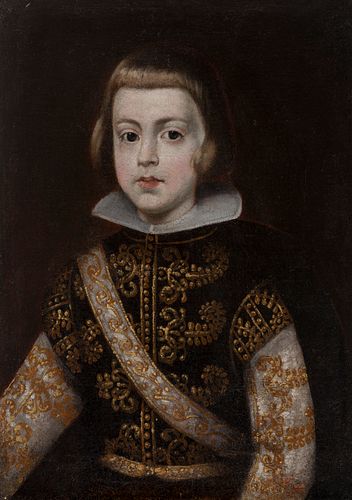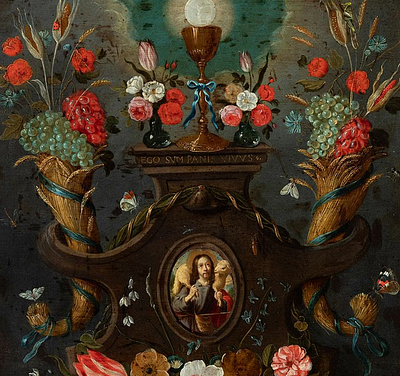Velázquez Circle; Formerly attributed to the master Don DIEGO DE VELÁZQUEZ (Seville, 1599 - Madrid, 1660). "Prince Baltasar Carlos". Oil on canvas.
Lot 30
About Seller
Setdart Auction House
Carrer Aragó 346
Barcelona
Spain
Setdart Subastas was born in 2004 and is currently the first online art auction in Spain with solidity, prestige and reliability guaranteed by our more than 60,000 users. Setdart has a young, dynamic and enterprising team ready to successfully manage the purchase and sale of art works through custom...Read more
Categories
Estimate:
EUR€50,000 - EUR€60,000
$52,083.33 - $62,500
Absentee vs Live bid
Two ways to bid:
- Leave a max absentee bid and the platform will bid on your behalf up to your maximum bid during the live auction.
- Bid live during the auction and your bids will be submitted real-time to the auctioneer.
Bid Increments
| Price | Bid Increment |
|---|---|
| EUR€0 | EUR€10 |
| EUR€200 | EUR€25 |
| EUR€500 | EUR€50 |
| EUR€1,000 | EUR€100 |
| EUR€3,000 | EUR€200 |
| EUR€5,000 | EUR€500 |
| EUR€10,000 | EUR€1,000 |
| EUR€20,000 | EUR€2,000 |
| EUR€50,000 | EUR€5,000 |
About Auction
By Setdart Auction House
Sep 21, 2021
Set Reminder
2021-09-21 10:00:00
2021-09-21 10:00:00
America/New_York
Bidsquare
Bidsquare : 21st September - ARAS JÁUREGUI Private Collection - Old Masters, 19th & 20th Century
https://www.bidsquare.com/auctions/setdart-auction-house/21st-september---aras-j-uregui-private-collection---old-masters-19th-20th-century-7429
Setdart Auction House sofia@setdart.com
Setdart Auction House sofia@setdart.com
- Lot Description
Velázquez Circle; Formerly attributed to the master Don DIEGO DE VELÁZQUEZ (Seville, 1599 - Madrid, 1660). "Prince Baltasar Carlos". Oil on canvas. Relined It presents repainting, restorations and extension of the canvas in the lower area. Measurements: 60 x 43 cm. Following similar models to those seen in the portrait of Prince Baltasar Carlos made by Velázquez in 1639, which belongs to the collection of the Kunsthistoriches Museum, in this work we see the little prince dressed in a black gala suit, adorned with golden tassels and white sleeves that seem to imitate silk. The sitter is a long-bust portrait of a young man with pearly skin and rosy cheeks, with short hair framing his features and leaving his neck visible, giving the figure greater stylisation. The work is notable for its psychological quality, showing a young man who is barely eleven years old, with an intelligent and steely expression, in keeping with the rank he holds as the future heir to the crown. It is worth mentioning that the protagonist, Balthasar Charles of Austria (Madrid, 1629 - Saragossa, 1646), son of King Philip IV and his first consort, Isabella of France, died prematurely. Due to his unexpected death, Philip IV was left without a male heir, thus triggering a serious dynastic crisis, as the only heir to the throne was the Infanta Maria Teresa. It is likely that this particular portrait belongs to the period when the marriage of Prince Balthasar Charles was being planned, as the figure is of a similar age to the portrait documented in the Kunsthistoriches Museum. Both the subject matter and the technical accuracy of this portrait led to an artistic attribution directly linked to Velázquez's artistic production, which was published in the magazine arte e ilustración. In addition, the Alcazar's inventory included a work of similar size and subject matter. Velázquez produced numerous works featuring the heir to the throne, Balthasar Carlos, and his son-in-law, Juan Bautista Martínez del Mazo, continued the tradition. Portraits of this type became popular, largely due to the political relations of the Habsburg house, which used these works both in the intimate family sphere and in the diplomatic sphere. In fact, a clear example of the proliferation of these court portraits was reflected in the exhibition Velázquez: and the Family of Philip IV at the Museo del Prado in 2014. This exhibition brought together a large number of portraits that showed the increase in demand for this type of work, caused by the birth of the infants and the arrival of a new queen. Thus demonstrating how both events led to the multiplication of court portraiture and the continuation of this work by various artists such as, for example, the aforementioned Juan Bautista Martínez del Mazo and Juan Carreño. It is therefore likely that this work, previously attributed to Velázquez, was produced by the workshop following the artist's models.
- Shipping Info
-
In-house shipping available. Please inquire at admin@setdart.com.
-
- Buyer's Premium



 EUR
EUR CAD
CAD AUD
AUD GBP
GBP MXN
MXN HKD
HKD CNY
CNY MYR
MYR SEK
SEK SGD
SGD CHF
CHF THB
THB
















